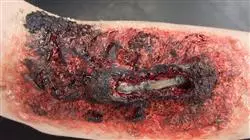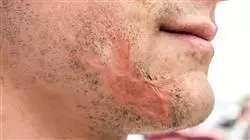University certificate
The world's largest faculty of medicine”
Introduction to the Program
Keeping up to date is key to providing better care to our patients. For this reason, at TECH we have designed this Masters Degree to be at the same level as the leading experts in Major Burns"

In a single program, this Masters Degree has all the information necessary for the care required by patients with severe burns. The multidisciplinary aspect of the specialization is noteworthy, as these patients are extremely complex and require many specialists working together, with the aim of achieving a rapid recovery.
In addition to the complete and fully up-to-date information, it offers the greatest experience from the teaching staff in the treatment of this type of patient. This experience is very valuable since there are very few burn wards and, therefore, the possibility of specialization is scarce.
An innovative part of this Masters Degree is that the theoretical information is complemented with graphs, diagrams, clinical case studies and explanatory videos that will be very useful to retain the information. It also highlights the main developments and provides recommended readings for many topics, especially for those that are new or controversial. As for the case studies, many of them are based on real-life situations, through which the ability to solve different scenarios will be exercised, in addition to serving as a self-assessment for learning.
In this way, the student will update or attain knowledge that will enable them to treat these patients and to work in a team through knowledge of issues related to other specialties. It will also enable the student to face the initial assessment and treatment, fundamental moments for the prognosis. In addition, it has the advantage of being a 100% online specialization, so the student can decide from where to study and at what time to do so, and in this way, they can flexibly self-direct their study schedule.
Boost your skills in treating patients with major burns and give your profession a boost"
This Masters Degree in Major Burns contains the most complete and up-to-date scientific program on the market. Its most notable features are:
- More than 75 clinical case studies are presented by experts in Burns
- The graphic, schematic, and practical contents with which they are created, provide scientific and practical information on the disciplines that are essential for professional practice
- The presentation of practical workshops on procedures and techniques
- An algorithm-based interactive learning system for decision-making in the clinical situations presented throughout the course
- Action protocols and clinical practice guidelines, which cover the most important latest developments in this specialist area
- Theoretical lessons, questions to the expert, debate forums on controversial topics, and individual reflection work
- Special emphasis on test-based medicine and research methodologies
- Content that is accessible from any fixed or portable device with an Internet connection
ThisMasters Degree is the best investment you can make in a specialization to update your knowledge of Major Burns"
The teaching staff includes a team of prestigious urologists, who bring their experience to this educational program, as well as renowned specialists from leading scientific societies.
Its multimedia content, developed with the latest educational technology, will allow professionals to learn in a contextual and situated learning environment, i.e., a simulated environment that will provide immersive specialization for real situations.
The design of this program focuses on Problem-Based Learning, by means of which professionals must try to solve the different professional practice situations that are presented to them throughout the academic year. To achieve this, you will be assisted by an innovative interactive video system developed by renowned experts in the field of Major Burns, with extensive teaching experience.
This Masters Degree will allow you to study from anywhere in the world. All you need is a computer or mobile device with an internet connection"

Our innovative teaching methodology will allow you to study as if you were dealing with real cases, thereby improving your skills"
Why study at TECH?
TECH is the world’s largest online university. With an impressive catalog of more than 14,000 university programs available in 11 languages, it is positioned as a leader in employability, with a 99% job placement rate. In addition, it relies on an enormous faculty of more than 6,000 professors of the highest international renown.

Study at the world's largest online university and guarantee your professional success. The future starts at TECH”
The world’s best online university according to FORBES
The prestigious Forbes magazine, specialized in business and finance, has highlighted TECH as “the world's best online university” This is what they have recently stated in an article in their digital edition in which they echo the success story of this institution, “thanks to the academic offer it provides, the selection of its teaching staff, and an innovative learning method aimed at educating the professionals of the future”
A revolutionary study method, a cutting-edge faculty and a practical focus: the key to TECH's success.
The most complete study plans on the university scene
TECH offers the most complete study plans on the university scene, with syllabuses that cover fundamental concepts and, at the same time, the main scientific advances in their specific scientific areas. In addition, these programs are continuously being updated to guarantee students the academic vanguard and the most in-demand professional skills. In this way, the university's qualifications provide its graduates with a significant advantage to propel their careers to success.
TECH offers the most comprehensive and intensive study plans on the current university scene.
A world-class teaching staff
TECH's teaching staff is made up of more than 6,000 professors with the highest international recognition. Professors, researchers and top executives of multinational companies, including Isaiah Covington, performance coach of the Boston Celtics; Magda Romanska, principal investigator at Harvard MetaLAB; Ignacio Wistumba, chairman of the department of translational molecular pathology at MD Anderson Cancer Center; and D.W. Pine, creative director of TIME magazine, among others.
Internationally renowned experts, specialized in different branches of Health, Technology, Communication and Business, form part of the TECH faculty.
A unique learning method
TECH is the first university to use Relearning in all its programs. It is the best online learning methodology, accredited with international teaching quality certifications, provided by prestigious educational agencies. In addition, this disruptive educational model is complemented with the “Case Method”, thereby setting up a unique online teaching strategy. Innovative teaching resources are also implemented, including detailed videos, infographics and interactive summaries.
TECH combines Relearning and the Case Method in all its university programs to guarantee excellent theoretical and practical learning, studying whenever and wherever you want.
The world's largest online university
TECH is the world’s largest online university. We are the largest educational institution, with the best and widest online educational catalog, one hundred percent online and covering the vast majority of areas of knowledge. We offer a large selection of our own degrees and accredited online undergraduate and postgraduate degrees. In total, more than 14,000 university degrees, in eleven different languages, make us the largest educational largest in the world.
TECH has the world's most extensive catalog of academic and official programs, available in more than 11 languages.
Google Premier Partner
The American technology giant has awarded TECH the Google Google Premier Partner badge. This award, which is only available to 3% of the world's companies, highlights the efficient, flexible and tailored experience that this university provides to students. The recognition as a Google Premier Partner not only accredits the maximum rigor, performance and investment in TECH's digital infrastructures, but also places this university as one of the world's leading technology companies.
Google has positioned TECH in the top 3% of the world's most important technology companies by awarding it its Google Premier Partner badge.
The official online university of the NBA
TECH is the official online university of the NBA. Thanks to our agreement with the biggest league in basketball, we offer our students exclusive university programs, as well as a wide variety of educational resources focused on the business of the league and other areas of the sports industry. Each program is made up of a uniquely designed syllabus and features exceptional guest hosts: professionals with a distinguished sports background who will offer their expertise on the most relevant topics.
TECH has been selected by the NBA, the world's top basketball league, as its official online university.
The top-rated university by its students
Students have positioned TECH as the world's top-rated university on the main review websites, with a highest rating of 4.9 out of 5, obtained from more than 1,000 reviews. These results consolidate TECH as the benchmark university institution at an international level, reflecting the excellence and positive impact of its educational model.” reflecting the excellence and positive impact of its educational model.”
TECH is the world’s top-rated university by its students.
Leaders in employability
TECH has managed to become the leading university in employability. 99% of its students obtain jobs in the academic field they have studied, within one year of completing any of the university's programs. A similar number achieve immediate career enhancement. All this thanks to a study methodology that bases its effectiveness on the acquisition of practical skills, which are absolutely necessary for professional development.
99% of TECH graduates find a job within a year of completing their studies.
Master's Degree in Major Burn Injuries
Between 80% and 90% of burns are of a domestic nature, according to a 2009 WHO study. While most of these cases tend to be minor injuries that can be treated at home with cold water, antibiotic-free ointments, or aloe vera layers, there are incidents where the tissue exposed to high temperatures is affected to such an extent that immediate and effective clinical intervention is imperative. The Master's Degree in Major Burns offered by TECH Global University is a necessary complement to a medical career, aiming to deepen the understanding of diagnosis and treatment for patients with severe burns, such as scalds or those resulting from electric shocks. As global leaders in virtual education, we specialize in providing high-quality training with self-paced classes, professors with extensive experience in the hospital sector, and unique multimedia content that leaves no room for mistakes or lack of motivation.
Obtain a medical degree in major burns
Between 17% and 18% of children who suffer burns in low-resource areas are left with temporary or permanent disabilities, according to the World Health Organization (WHO). In countries like Spain, nearly 120,000 people suffer from some form of injury in this category, with children being the most affected. Meanwhile, in places like Mexico, a report from the Salud Pública magazine indicates that during the COVID-19 lockdown, severe burn accidents increased. This data underscores the critical importance of training and updating doctors on this subject. Through our postgraduate program, you will be able to help rehabilitate patients with deep dermatological scars, covering topics such as primary care, burn classification, surgical management, fluid therapy, and even pediatric burns. All of this is delivered through flexible classes without fixed schedules and innovative methodological frameworks such as the relearning system. What are you waiting for to enroll?







